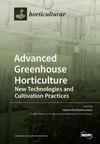An Updated Isotopic Database of Fertilizers Used in Intensive Organic Farming: A Case Study on Protein Hydrolyzed Derivatives and Chelated Nutrients
IF 3.1
3区 农林科学
Q1 HORTICULTURE
引用次数: 0
Abstract
The global demand for organic food products has rapidly increased over the last years, becoming an emerging niche market targeting the high-income segment. The higher retailing price for organic food products may increase the risk of fraudulent practices at the different stages of the food supply chain, and consequently, substantial control is needed. Currently, the authentication of organic food products, such as those of plant origin, remains a key challenge in analytical chemistry. While stable isotopes have emerged as a powerful tool for this purpose, most studies have focused on crops, missing the agricultural inputs used for fertilization that influence the isotopic values of the crops. In this study, we aimed to isotopically characterize commonly used fertilizers, soil conditioners, and micronutrient fertilizers in intensive organic agriculture in the largest organic production region in the world (Almería, Spain). Our goal was to clarify the limitations that nitrogen isotopic fingerprinting presents for the fertilizer input industry and to characterize the organic inputs. The conventional fertilizers analyzed in this study showed low δ15N values compared to their organic counterparts, except for some plant-based fertilizers, protein hydrolyzed fertilizers, and chelated nutrients. Both protein hydrolyzed fertilizers and micronutrient fertilizers presented a wide range of variability in their δ15N values, including some very low or even negative values, more similar to those of conventional fertilizers. The results of this study highlight the challenges of authenticating organic foods in agriculture when using nitrogen isotope analysis.集约化有机农业所用肥料的最新同位素数据库:蛋白质水解衍生物和螯合营养素案例研究
过去几年,全球对有机食品的需求迅速增长,已成为针对高收入人群的新兴利基市场。有机食品的零售价格较高,可能会增加在食品供应链的不同阶段出现欺诈行为的风险,因此需要进行实质性控制。目前,有机食品(如植物源有机食品)的鉴定仍是分析化学领域的一项关键挑战。虽然稳定同位素已成为实现这一目的的有力工具,但大多数研究都集中在农作物上,而忽略了影响农作物同位素值的施肥农业投入。在这项研究中,我们旨在对世界上最大的有机生产地区(西班牙阿尔梅里亚)集约有机农业中常用的肥料、土壤改良剂和微量元素肥料进行同位素定性。我们的目标是澄清氮同位素指纹图谱对肥料投入行业的限制,并确定有机肥料投入的特征。与有机肥料相比,本研究分析的常规肥料的 δ15N 值较低,但一些植物基肥料、蛋白水解肥料和螯合营养素除外。蛋白质水解肥料和微量营养元素肥料的 δ15N 值变化范围很大,包括一些很低甚至是负值的肥料,与传统肥料更为相似。这项研究的结果突显了利用氮同位素分析鉴定农业有机食品所面临的挑战。
本文章由计算机程序翻译,如有差异,请以英文原文为准。
求助全文
约1分钟内获得全文
求助全文
文献相关原料
| 公司名称 | 产品信息 | 采购帮参考价格 |
|---|

 求助内容:
求助内容: 应助结果提醒方式:
应助结果提醒方式:


